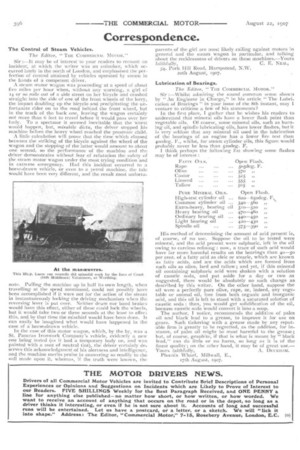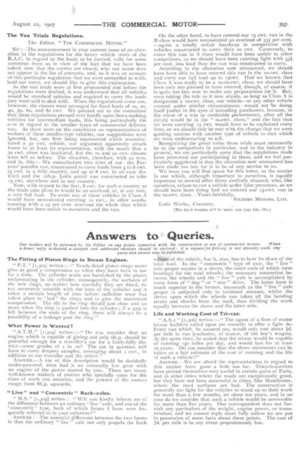Correspondence.
Page 16

Page 17

If you've noticed an error in this article please click here to report it so we can fix it.
The Control of Steam Vehicles.
The Editor, " THE COMMERCIAL MOTOR."
Sir :—It may be of interest to your readers to recount an incident, at which the writer was an onlooker, which occurred lately in the north of London, and emphasised the perfection of control attained by vehicles operated by steam in the hands of a competent driver.
A steam motor wagon was proceeding at a speed of about five miles per hour when, without any warning, a girl of 14 or so rode out of a side street on her bicycle and crashed straight into the Side of one of the front wheels of the lorry, the impact doubling up the bicycle and. precipitating the unfortunate rider on to the road behind the front wheel, but in the track of the back one, leaving the wagon certainly not more than 6 feet to travel before it would pass over her body. To a spectator it seemed inevitable that the wOrst would happen, but, mirabile dictu, the driver stopped his machine before the heavy wheel reached the prostrate child. A little calculation will prove that the time which elaosed between the striking of the bicycle against the wheel of the wagon and the stopping of the latter would amount to about one second, 90 the performance of the machine and the driver demonstrates without fear of refutation the safety of the steam motor wagon under the most trying condition and in extreme emergency.. Had this incident occurred to a horse-drawn vehicle, or even to a petrel machine, the tale would have been very different, and the result most unfortu
nate. Pulling the machine up in half its own length, when travelling at the speed mentioned, could not possibly have been accomplished if it were not for the action of the steam in instantaneously locking the driving mechanism when the reversing lever is put over. Neither drum nor band brakes would have this effect, either of these could lock the wheels, but it would take two or three seconds at the least to effect this, and by that time the mischief would have been done. It can easily be imagined what would have happened in the case of a horse-drawn vehicle.
In the case of this motor wagon, which, by the by, was a St. Pancras Ironwork Company's vehicle, evidently a new one being tested (as it had a temporary body on, and was painted with a coat of neutral tint), the driver certainly deserves this acknowledgment of his alertness and intelligence, and the machine merits praise in answering so readily to the call made upon it, whereas, if the truth were known, the parents of the girl are most likely, railing against motors in general and the steam wagon in particular, and talking about the recklessness of drivers on these machines.—Yours
faithfully, C. E. NEAL, 54, Park Hill Road, Hampstead, N.W. 20th August, 1907.
Lubrication of Bearings.
The Editor, " TUE COMMERCIAL ;MOTOR."
Sir :—Whilst admiring the sound common sense shown by " An Engineer in Charge," in his article " The Lubrication of Bearings " in your issue of the 8th instant, may I venture to criticise a few of his statements?
In the first place, I gather that he wishes his readers to understand that mineral oil5 have a lower flash point than vegetable oils. Of course, some mineral oils, such as burning oil, and spindle lubricating oils, have lower flashes, but it is very seldom that any mineral oil used in the lubrication of the bearings of an engine has a lower fire test than 400deg. F., whilst, for steam cylinder oils, this figure would probably never be less than 52odeg. F.
I think perhaps the following list showing some flashes His method of determining the amount of acid present is, of course, of no use. Suppose the oil to be tested were mineral, and the acid present were sulphuric, left in the oil owing to careless refining : now, a trace of such acid would have far more harmful results on the bearings than 40-50 per cent. of a fatty acid as oleic or stearic, which are known as fatty acids, and are the acids which are formed from such oils as olive, lard and tallow; and yet, if this mineral oil containing sulphuric acid were shaken with a solution of caustic soda, and put aside for a day or two as suggested, there would be absolutely no such change as described by this writer. On the other hand, suppose the oil were a perfectly pure olive, rape, or, indeed, any vegetable or animal oil, free from both organic and inorganic acid, and this oil is left to stand with a saturated solution of caustic soda : then, you would get solidification of the oil, because caustic soda would convert it into a soap.
The author, I notice, recommends the addition of palm oil rind black lead to a grease, to improve it for use on gears. Such tinkering with a grease made by any reputable firm is greatly to be regretted, as the addition, for instance, of palm oil might be most harmful to the grease; but, of course, graphite, if that is what is meant by " black lead," can do little or no harm, so long as it is of the finest quality ; on the other hand, it may be of great use.— Yours faithfully, A. Duets:11Am. Phcunix Wharf, Miliwafi, E., 17th August, 1907.
The Van Trials Regulations.
The Editor, " THE COMMERCIAL MOTOR."
Sir :—The announcement in your current issue of an alteration in the regulations for the heavy vehicle trials of the R.A.C. in regard to the loads to be carried, calls for some comment from us in view of the fact that we have been asked, now that the entries are closed, why our name does not appear in the list of entrants, and, as it was on account of this particular regulation that we were compelled to with hold our entry, we should like to give this explanation.
As the van trials were at first propounded and before the regulations were drafted, it was understood that all vehicles would he standard vehicles and required to carry the loads they were sold to deal with. When the regulations came out, however, the classes were arranged for fixed loads of 10, 20, 40, so, 6o, and So cwt. We pointed out to the committee that these regulations pressed very hardly upon firms making vehicles for intermediate loads, this being particularly the case in regard to the smaller types of commercial delivery van, As there were on the committee no representatives of makers of these smaller-type vehicles, our suggestions were ignored, but, one firm being represented which manufactured a 30 cwt, vehicle, our argument apparently struck home to at least its representative, with the result that 30 cwt. class wa.s instituted, hut the TO and 20 cwt. classes were left as before. The situation, therefore, with us was, and is, this :—We manufacture two sizes of car i the Parsons' paraffin van, constructed to carry loads from 5 to S cwt. (5 cwt. in a hilly country, and up to 8 cwt. in an easy district) and the 12h.p. Lotis petrol van constructed to take 15 cwt. anywhere and in any country.
Now, with regard to the first, 8 cwt. for such a country as the trials take place in would be an overload, or, at any rate, a very full load. To enter one of these vehicles in Class A would have necessitated carrying so cwt., in other words, running with a 25 per cent, overload the Whole time which would have been unfair to ourselves and the van.
On the other hand, to have entered our 15 cwt. van in the B class would have necessitated an overload of 33h per cent. —again a totally unfair haudicap in competition with vehicles constructed to carry their 20 cwt. Conversely, to enter this van in A class would have been unfair to other competitors, as we should have been running light with 331. per cent. less load than the van was constructed to carry.
According to the alteration now announced, we should have been able to have entered this van in the so-ewt. class and carry our full load up to ssciwt. Had we known that Class A was really to be a so-so-cwt. class, we should have been only too pleased to have entered, though, of course, it is quite too late now to make any preparations for it. But, even taking the rule as it now stands, so long as Class A is
designated a so-cwt. class, our vehicle or any other vehicle entered under similar circumstances—would not tie doing itself justice in the eyes of intending purchasers, because, in the event of a win or creditable performance, after all the recerd would be in the " so-cwt. class," and the fact that we were carrying i5 cwt. would have to he explained every time, or we should only be met with the charge that we were quoting success with another type of vehicle to that which we were endeavouring to sell.
Recognising the great value those trials must necessarily be to the competitors in particular, and to the industry in general, we are particularly sorry that the regulations made have prevented our participating in them, and we feel particularly aggrieved in that the alteration now announced has been made too late for it to be of any service to us.
We trust you will find space for this letter, as the matter is one which, although important to ourselves, is equally important to several other firms similarly situated; who, like ourselves, refuse to run a vehicle under false pretences,. as we should have been doing had we entered our 15-.cwt, van in the so-cwt. class.—Yours faithfully, STURMEY MOTORS, LTD.. Lotis Works, Coventry.
[The flx.sd vi,ightis will b3 used: s3e pigs 5)1„—Eni]






















